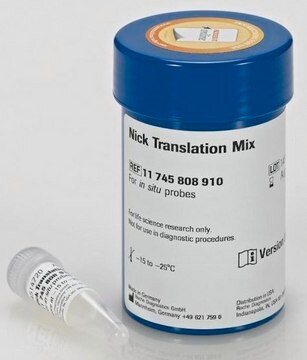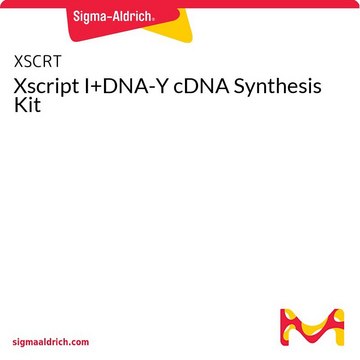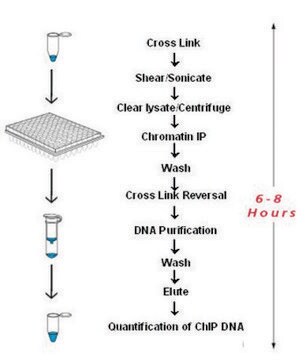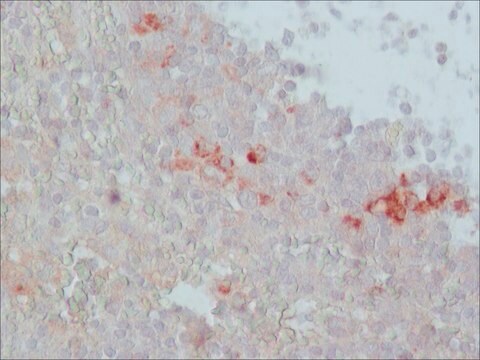11745824910
Roche
Biotin-Nick Translation Mix
suitable for hybridization, solution, sufficient for 40 labeling reactions, pkg of 160 μL
Synonyme(s) :
nick translation
Se connecterpour consulter vos tarifs contractuels et ceux de votre entreprise/organisme
About This Item
Code UNSPSC :
41105500
Produits recommandés
Forme
solution
Niveau de qualité
Utilisation
sufficient for 40 labeling reactions
Conditionnement
pkg of 160 μL
Fabricant/nom de marque
Roche
Technique(s)
hybridization: suitable
Température de stockage
−20°C
Description générale
Convenient enzyme and nucleotide mixture.
Nick translation utilizes a combination of DNase and DNA Polymerase to nick one strand of the DNA helix, then incorporates labeled nucleotides as the polymerase examines, or "proofreads" the nicked site. The molar ratio of Biotin-16-dUTP to dTTP is adjusted to ensure that every 20th to 25th nucleotide in the newly synthesized DNA is modified with biotin. This density of haptens in the DNA yields the highest sensitivity in the immunological detection reaction.
Large plasmids, cosmids, and PCR fragments are all regularly used with this method, and the DNA can be linearized or supercoiled. Individual templates produce consistent results in the standard 90-minutes reaction, and result in an average probe length of 200 base pairs up to 500 base pairs.
Nick translation utilizes a combination of DNase and DNA Polymerase to nick one strand of the DNA helix, then incorporates labeled nucleotides as the polymerase examines, or "proofreads" the nicked site. The molar ratio of Biotin-16-dUTP to dTTP is adjusted to ensure that every 20th to 25th nucleotide in the newly synthesized DNA is modified with biotin. This density of haptens in the DNA yields the highest sensitivity in the immunological detection reaction.
Large plasmids, cosmids, and PCR fragments are all regularly used with this method, and the DNA can be linearized or supercoiled. Individual templates produce consistent results in the standard 90-minutes reaction, and result in an average probe length of 200 base pairs up to 500 base pairs.
Spécificité
Heat inactivation: Stop the reaction by adding 1 μl 0.5 M EDTA (pH 8.0) and heating to 65 °C for 10 minutes.
Application
For generation of highly sensitive probes for in situ hybridization labeled with Biotin-16-dUTP.
Note: The mix can also be used for filter hybridization techniques, however, for highly sensitive filter hybridization probes, we recommend that you use Biotin-High Prime from Roche Applied Science.
For nonradioactive labeling of in situ probes with other haptens, Roche Applied Science offers the DIG-Nick Translation Mix or the Nick Translation Mix.
Note: The mix can also be used for filter hybridization techniques, however, for highly sensitive filter hybridization probes, we recommend that you use Biotin-High Prime from Roche Applied Science.
For nonradioactive labeling of in situ probes with other haptens, Roche Applied Science offers the DIG-Nick Translation Mix or the Nick Translation Mix.
Qualité
Function tested in a dot blot assay.
Principe
The nick translation method is based on the ability of DNase I to introduce randomly distributed nicks into DNA at low enzyme concentrations in the presence of MgCl2. E. coli DNA Polymerase I synthesizes DNA complementary to the intact strand in a 5′ → 3′direction using the 3′-OH termini of the nick as a primer. The 5′ → 3′ exonucleolytic activity of DNA polymerase I simultaneously removes nucleotides in the direction of synthesis. The polymerase activity sequentially replaces the removed nucleotides with isotope-labeled or hapten-labeled deoxyribonucleoside triphosphates. At low temperature (+15°C), the unlabeled DNA in the reaction is thus replaced by newly synthesized labeled DNA.
Forme physique
1 vial with 5x concentrated stabilized reaction buffer in 50% glycerol (v/v) and DNA Polymerase I, DNase I, 0.25mM dATP, 0.25mM dCTP, 0.25mM dGTP, 0.17mM dTTP and 0.08mM Biotin-16-dUTP.
Notes préparatoires
Assay Time: 100 minutes
Sample Materials
Supercoiled and linearized plasmid DNA
Supercoiled and linearized cosmid DNA
Purified PCR products
Note: Denaturing of the template before nick translation is not required.
Sample Materials
Supercoiled and linearized plasmid DNA
Supercoiled and linearized cosmid DNA
Purified PCR products
Note: Denaturing of the template before nick translation is not required.
Autres remarques
For life science research only. Not for use in diagnostic procedures.
Code de la classe de stockage
12 - Non Combustible Liquids
Classe de danger pour l'eau (WGK)
WGK 1
Point d'éclair (°F)
No data available
Point d'éclair (°C)
No data available
Certificats d'analyse (COA)
Recherchez un Certificats d'analyse (COA) en saisissant le numéro de lot du produit. Les numéros de lot figurent sur l'étiquette du produit après les mots "Lot" ou "Batch".
Déjà en possession de ce produit ?
Retrouvez la documentation relative aux produits que vous avez récemment achetés dans la Bibliothèque de documents.
Les clients ont également consulté
Shujun Zhou et al.
Breeding science, 64(1), 97-102 (2014-07-06)
Based on a recent hypothesis, "Five same genomes of endosperm are essential for its development in Lilium", it is expected that allotriploid lily (OTO) can be hybridized with diploid Oriental lily (OO) for introgression breeding in Lilium L.. To test
A Sepsi et al.
TAG. Theoretical and applied genetics. Theoretische und angewandte Genetik, 116(6), 825-834 (2008-01-29)
In situ hybridization (multicolor GISH and FISH) was used to characterize the genomic composition of the wheat-Thinopyrum ponticum partial amphiploid BE-1. The amphiploid is a high-protein line having resistance to leaf rust (Puccinia recondita f. sp. tritici) and powdery mildew
Cornelia E Zorca et al.
Proceedings of the National Academy of Sciences of the United States of America, 112(13), E1587-E1593 (2015-03-15)
Naive CD4 T cells differentiate into several effector lineages, which generate a stronger and more rapid response to previously encountered immunological challenges. Although effector function is a key feature of adaptive immunity, the molecular basis of this process is poorly
Kristin D Kernohan et al.
MethodsX, 1, 30-35 (2014-01-01)
Emerging studies demonstrate that three-dimensional organization of chromatin in the nucleus plays a vital role in regulating the genome. DNA fluorescent in situ hybridization (FISH) is a common molecular technique used to visualize the location of DNA sequences. The vast
Shijun Li et al.
Nucleic acids research, 41(4), 2659-2672 (2013-01-12)
Titin, a sarcomeric protein expressed primarily in striated muscles, is responsible for maintaining the structure and biomechanical properties of muscle cells. Cardiac titin undergoes developmental size reduction from 3.7 megadaltons in neonates to primarily 2.97 megadaltons in the adult. This
Notre équipe de scientifiques dispose d'une expérience dans tous les secteurs de la recherche, notamment en sciences de la vie, science des matériaux, synthèse chimique, chromatographie, analyse et dans de nombreux autres domaines..
Contacter notre Service technique









